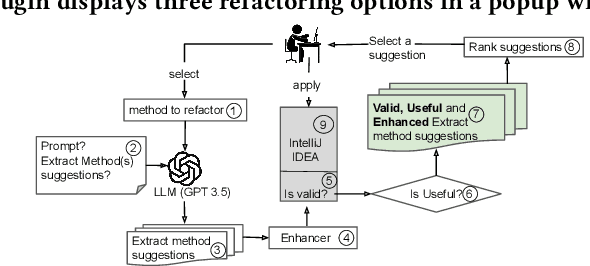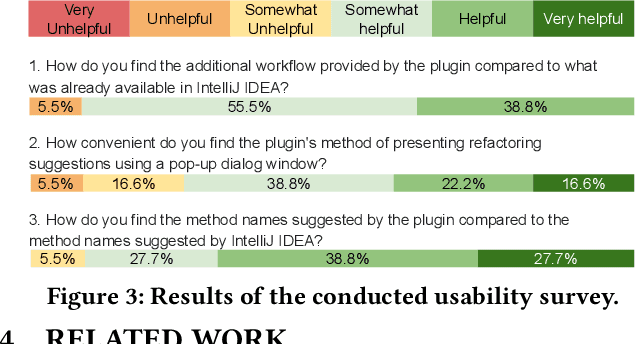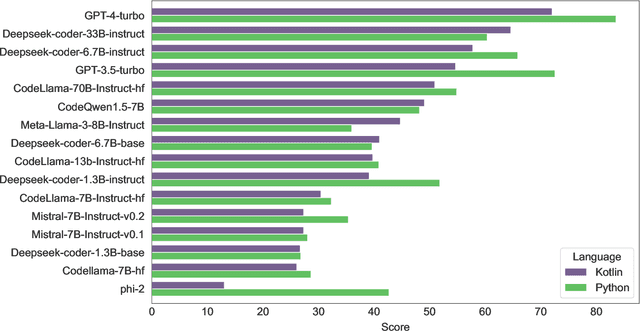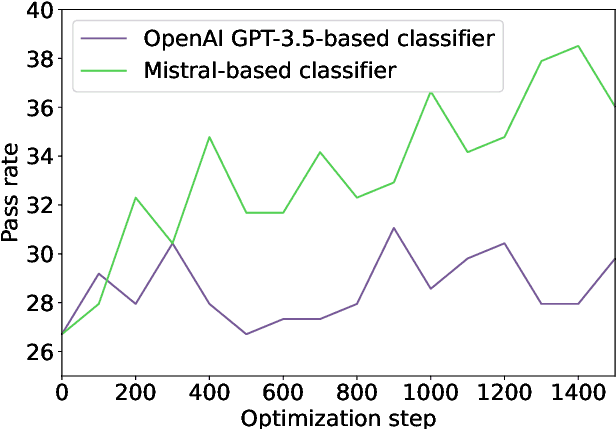Egor Bogomolov
Practical Code RAG at Scale: Task-Aware Retrieval Design Choices under Compute Budgets
Oct 23, 2025Abstract:We study retrieval design for code-focused generation tasks under realistic compute budgets. Using two complementary tasks from Long Code Arena -- code completion and bug localization -- we systematically compare retrieval configurations across various context window sizes along three axes: (i) chunking strategy, (ii) similarity scoring, and (iii) splitting granularity. (1) For PL-PL, sparse BM25 with word-level splitting is the most effective and practical, significantly outperforming dense alternatives while being an order of magnitude faster. (2) For NL-PL, proprietary dense encoders (Voyager-3 family) consistently beat sparse retrievers, however requiring 100x larger latency. (3) Optimal chunk size scales with available context: 32-64 line chunks work best at small budgets, and whole-file retrieval becomes competitive at 16000 tokens. (4) Simple line-based chunking matches syntax-aware splitting across budgets. (5) Retrieval latency varies by up to 200x across configurations; BPE-based splitting is needlessly slow, and BM25 + word splitting offers the best quality-latency trade-off. Thus, we provide evidence-based recommendations for implementing effective code-oriented RAG systems based on task requirements, model constraints, and computational efficiency.
Diff-XYZ: A Benchmark for Evaluating Diff Understanding
Oct 14, 2025Abstract:Reliable handling of code diffs is central to agents that edit and refactor repositories at scale. We introduce Diff-XYZ, a compact benchmark for code-diff understanding with three supervised tasks: apply (old code $+$ diff $\rightarrow$ new code), anti-apply (new code $-$ diff $\rightarrow$ old code), and diff generation (new code $-$ old code $\rightarrow$ diff). Instances in the benchmark are triples $\langle \textit{old code}, \textit{new code}, \textit{diff} \rangle$ drawn from real commits in CommitPackFT, paired with automatic metrics and a clear evaluation protocol. We use the benchmark to do a focused empirical study of the unified diff format and run a cross-format comparison of different diff representations. Our findings reveal that different formats should be used depending on the use case and model size. For example, representing diffs in search-replace format is good for larger models in the diff generation scenario, yet not suited well for diff analysis and smaller models. The Diff-XYZ benchmark is a reusable foundation for assessing and improving diff handling in LLMs that can aid future development of diff formats and models editing code. The dataset is published on HuggingFace Hub: https://huggingface.co/datasets/JetBrains-Research/diff-xyz.
Challenge on Optimization of Context Collection for Code Completion
Oct 05, 2025Abstract:The rapid advancement of workflows and methods for software engineering using AI emphasizes the need for a systematic evaluation and analysis of their ability to leverage information from entire projects, particularly in large code bases. In this challenge on optimization of context collection for code completion, organized by JetBrains in collaboration with Mistral AI as part of the ASE 2025 conference, participants developed efficient mechanisms for collecting context from source code repositories to improve fill-in-the-middle code completions for Python and Kotlin. We constructed a large dataset of real-world code in these two programming languages using permissively licensed open-source projects. The submissions were evaluated based on their ability to maximize completion quality for multiple state-of-the-art neural models using the chrF metric. During the public phase of the competition, nineteen teams submitted solutions to the Python track and eight teams submitted solutions to the Kotlin track. In the private phase, six teams competed, of which five submitted papers to the workshop.
GitGoodBench: A Novel Benchmark For Evaluating Agentic Performance On Git
May 28, 2025Abstract:Benchmarks for Software Engineering (SE) AI agents, most notably SWE-bench, have catalyzed progress in programming capabilities of AI agents. However, they overlook critical developer workflows such as Version Control System (VCS) operations. To address this issue, we present GitGoodBench, a novel benchmark for evaluating AI agent performance on VCS tasks. GitGoodBench covers three core Git scenarios extracted from permissive open-source Python, Java, and Kotlin repositories. Our benchmark provides three datasets: a comprehensive evaluation suite (900 samples), a rapid prototyping version (120 samples), and a training corpus (17,469 samples). We establish baseline performance on the prototyping version of our benchmark using GPT-4o equipped with custom tools, achieving a 21.11% solve rate overall. We expect GitGoodBench to serve as a crucial stepping stone toward truly comprehensive SE agents that go beyond mere programming.
EnvBench: A Benchmark for Automated Environment Setup
Mar 18, 2025Abstract:Recent advances in Large Language Models (LLMs) have enabled researchers to focus on practical repository-level tasks in software engineering domain. In this work, we consider a cornerstone task for automating work with software repositories-environment setup, i.e., a task of configuring a repository-specific development environment on a system. Existing studies on environment setup introduce innovative agentic strategies, but their evaluation is often based on small datasets that may not capture the full range of configuration challenges encountered in practice. To address this gap, we introduce a comprehensive environment setup benchmark EnvBench. It encompasses 329 Python and 665 JVM-based (Java, Kotlin) repositories, with a focus on repositories that present genuine configuration challenges, excluding projects that can be fully configured by simple deterministic scripts. To enable further benchmark extension and usage for model tuning, we implement two automatic metrics: a static analysis check for missing imports in Python and a compilation check for JVM languages. We demonstrate the applicability of our benchmark by evaluating three environment setup approaches, including a simple zero-shot baseline and two agentic workflows, that we test with two powerful LLM backbones, GPT-4o and GPT-4o-mini. The best approach manages to successfully configure 6.69% repositories for Python and 29.47% repositories for JVM, suggesting that EnvBench remains challenging for current approaches. Our benchmark suite is publicly available at https://github.com/JetBrains-Research/EnvBench. The dataset and experiment trajectories are available at https://jb.gg/envbench.
Drawing Pandas: A Benchmark for LLMs in Generating Plotting Code
Dec 03, 2024Abstract:This paper introduces the human-curated PandasPlotBench dataset, designed to evaluate language models' effectiveness as assistants in visual data exploration. Our benchmark focuses on generating code for visualizing tabular data - such as a Pandas DataFrame - based on natural language instructions, complementing current evaluation tools and expanding their scope. The dataset includes 175 unique tasks. Our experiments assess several leading Large Language Models (LLMs) across three visualization libraries: Matplotlib, Seaborn, and Plotly. We show that the shortening of tasks has a minimal effect on plotting capabilities, allowing for the user interface that accommodates concise user input without sacrificing functionality or accuracy. Another of our findings reveals that while LLMs perform well with popular libraries like Matplotlib and Seaborn, challenges persist with Plotly, highlighting areas for improvement. We hope that the modular design of our benchmark will broaden the current studies on generating visualizations. Our benchmark is available online: https://huggingface.co/datasets/JetBrains-Research/plot_bench. The code for running the benchmark is also available: https://github.com/JetBrains-Research/PandasPlotBench.
Long Code Arena: a Set of Benchmarks for Long-Context Code Models
Jun 17, 2024



Abstract:Nowadays, the fields of code and natural language processing are evolving rapidly. In particular, models become better at processing long context windows - supported context sizes have increased by orders of magnitude over the last few years. However, there is a shortage of benchmarks for code processing that go beyond a single file of context, while the most popular ones are limited to a single method. With this work, we aim to close this gap by introducing Long Code Arena, a suite of six benchmarks for code processing tasks that require project-wide context. These tasks cover different aspects of code processing: library-based code generation, CI builds repair, project-level code completion, commit message generation, bug localization, and module summarization. For each task, we provide a manually verified dataset for testing, an evaluation suite, and open-source baseline solutions based on popular LLMs to showcase the usage of the dataset and to simplify adoption by other researchers. We publish the benchmark page on HuggingFace Spaces with the leaderboard, links to HuggingFace Hub for all the datasets, and link to the GitHub repository with baselines: https://huggingface.co/spaces/JetBrains-Research/long-code-arena.
EM-Assist: Safe Automated ExtractMethod Refactoring with LLMs
May 31, 2024


Abstract:Excessively long methods, loaded with multiple responsibilities, are challenging to understand, debug, reuse, and maintain. The solution lies in the widely recognized Extract Method refactoring. While the application of this refactoring is supported in modern IDEs, recommending which code fragments to extract has been the topic of many research tools. However, they often struggle to replicate real-world developer practices, resulting in recommendations that do not align with what a human developer would do in real life. To address this issue, we introduce EM-Assist, an IntelliJ IDEA plugin that uses LLMs to generate refactoring suggestions and subsequently validates, enhances, and ranks them. Finally, EM-Assist uses the IntelliJ IDE to apply the user-selected recommendation. In our extensive evaluation of 1,752 real-world refactorings that actually took place in open-source projects, EM-Assist's recall rate was 53.4% among its top-5 recommendations, compared to 39.4% for the previous best-in-class tool that relies solely on static analysis. Moreover, we conducted a usability survey with 18 industrial developers and 94.4% gave a positive rating.
Kotlin ML Pack: Technical Report
May 29, 2024



Abstract:In this technical report, we present three novel datasets of Kotlin code: KStack, KStack-clean, and KExercises. We also describe the results of fine-tuning CodeLlama and DeepSeek models on this data. Additionally, we present a version of the HumanEval benchmark rewritten by human experts into Kotlin - both the solutions and the tests. Our results demonstrate that small, high-quality datasets (KStack-clean and KExercises) can significantly improve model performance on code generation tasks, achieving up to a 16-point increase in pass rate on the HumanEval benchmark. Lastly, we discuss potential future work in the field of improving language modeling for Kotlin, including the use of static analysis tools in the learning process and the introduction of more intricate and realistic benchmarks.
From Commit Message Generation to History-Aware Commit Message Completion
Aug 15, 2023



Abstract:Commit messages are crucial to software development, allowing developers to track changes and collaborate effectively. Despite their utility, most commit messages lack important information since writing high-quality commit messages is tedious and time-consuming. The active research on commit message generation (CMG) has not yet led to wide adoption in practice. We argue that if we could shift the focus from commit message generation to commit message completion and use previous commit history as additional context, we could significantly improve the quality and the personal nature of the resulting commit messages. In this paper, we propose and evaluate both of these novel ideas. Since the existing datasets lack historical data, we collect and share a novel dataset called CommitChronicle, containing 10.7M commits across 20 programming languages. We use this dataset to evaluate the completion setting and the usefulness of the historical context for state-of-the-art CMG models and GPT-3.5-turbo. Our results show that in some contexts, commit message completion shows better results than generation, and that while in general GPT-3.5-turbo performs worse, it shows potential for long and detailed messages. As for the history, the results show that historical information improves the performance of CMG models in the generation task, and the performance of GPT-3.5-turbo in both generation and completion.
 Add to Chrome
Add to Chrome Add to Firefox
Add to Firefox Add to Edge
Add to Edge